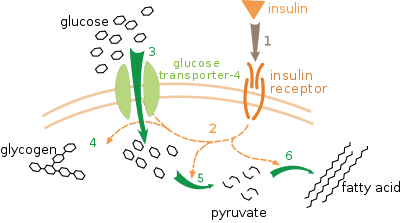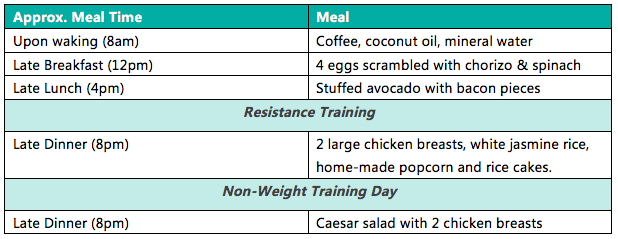Carb Backloading (CBL) has become yet another highly talked about modern nutrition protocol over the last number of years.
Carb Backloading, like many of the modern nutrition protocols goes against traditional nutrition and dieting recommendations.
Tradition tells us that we must eat our carbohydrates early in the day, otherwise the energy from this will not be used and therefore will be stored as body fat.
Then Carb Backloading was published and it told us to eat not just some, but all, of our carbohydrates at night.
CBL has therefore gone against typical advice from fitness professionals and has gained a lot of attention.
In this article, you will learn what Carb Backloading is, how it works, a sample Carb backloading diet plan and all of the pros and cons when following such a protocol.
Before digging in, as a valued reader of the blog, I’d like to extend you an invitation to our upcoming and totally FREE online training workshop:
‘The Proven Nutrition Strategies of Elite Trainers’.
This workshop is for you if you want to finally learn the best nutrition protocols and evidenced-based strategies to help your clients achieve life-changing results.
This workshop is our most complete training on how to make nutrition coaching easy and profitable.
All you need to do to attend is click here to register your free spot.

What is Carb Backloading?
CBL in its most basic form is essentially the practice of delaying the intake of your daily carbohydrates.
The term ‘Carb Backloading’ was given to this practice after American training and nutrition consultant John Kiefer published his eBook called ‘Carb Backloading’.
There were many books previously published on carbohydrate cycling, but none as extensively researched and referenced as Kiefer’s. Due to some clever marketing, the book quickly became a hit, and one of the most talked about modern protocols.
Basic Carb backloading Summary
- Shift calories to later in the day, eating lighter in the morning and early afternoon, and feasting at night. This may include skipping breakfast.
- Keep carbs at an absolute minimum throughout the day until training.
- Train in the afternoon, at around 5pm or so.
- Start ingesting carbs after your training session, up to 30 minutes later.
- Continue eating carbs throughout the evening.
These are the key cornerstones to the CBL template, which appears at first to be heavily centered around nutrient training.
How Does Carb BackLoading Work
The heavy reliance on nutrient timing from the protocol is based around controlling and manipulating cellular, hormonal and biological functions within the body.
The reasoning for delaying carbohydrates during the day is to limit the release of insulin in the body.
Insulin’s main function in the body is to be anabolic; it wants to build stuff. It makes things grow, from muscle, fat mass, and even glycogen.
Insulin helps cells absorb raw materials (nutrients) and when there is too much of it we can blunt fat burning and become insulin resistant in the process.
Carbohydrates are known as the main nutrient for triggering insulin. When insulin is high, it increases the efficiency of fat storage (sends nutrients to fat cells) – insulin makes storing fat easier for the body.
The CBL protocol is therefore based on this theory, and is structured to control insulin to not interfere with fat burning yet still promote muscle building and recovery.
CBL is also further founded on the introduction of carbohydrates following resistance training. Ideally this is completed in the afternoon to ensure plenty of time has been given to maximize the enhanced fat burning effect of keeping insulin low throughout the day.
Also, CBL states that insulin sensitivity and fat sensitivity is highest in the morning. Insulin sensitivity is good, it means our body has the ability to handle nutrients better, whereas fat sensitivity is bad, it means we have the ability to store more fat.
As the day goes on both insulin and fat sensitivity decrease and we therefore have a reduced ability to handle nutrients and store body fat.
By the inclusion of mid-late afternoon weight training, we can restore insulin sensitivity but not fat sensitivity. This results in the body’s ability to use the nutrients we provide it with post workout, but store less of it as fat.
This occurs by the relocation of our GLUT (pronounce ‘gloot’) glucose transporters.
GLUT comprises a family of proteins, and acts as a solvent within the body – it therefore carries things.
GLUTs can carry a number of nutrients, but their main role is to transport glucose. They are located in the jelly-like outer coatings of cells and are normally exposed on the cell’s surface.
The main anomaly to this are GLUT’s 4 & 12 (there are 14 in total) which are located below the surface of the cell membrane, preventing them from transporting glucose.
These GLUT’s also appear to be the main pathways through which high volumes of glucose enter the cell (both muscular and fat).
The more insulin sensitive someone can become, the more they can recruit GLUTs 4 & 12 and bring them to the surface of the cell to transport glucose into them.
Resistance training does just this, but only for muscle cells, not fat cells. Therefore by delaying weight training until late afternoon, we can re-sensitise the muscle cell to glucose, but fat sensitivity has naturally decreased.
It is also suggested that resistance training not only causes GLUT to re locate without insulin, but also increases the amount and concentration of GLUTs 4 and 12 in muscle cells.

The diagram above shows the effect of insulin on glucose uptake and metabolism. Insulin binds to its receptor (1), which in turn starts many protein activation cascades (2). These include: translocation of Glut-4 transporter to the plasma membrane and influx of glucose (3), glycogen synthesis (4), glycolysis (5) and fatty acid synthesis (6).
Resistance training equips muscle cells to absorb glucose at a faster rate, either for storage or energy production. CBL has therefore been one of the first protocols to combine nutrient and weight training timing together.
This protocol is therefore aimed at intermediate to advanced fitness people with an interest in maximizing body composition.
Setting Up a CBL Diet
Aside from simply delaying daily carbohydrate intake to the evening (or post workout), Kiefer’s book goes into in-depth information on how to maximize the effects previously discussed i.e.: maximizing fat burning and glucose sensitivity.
BREAKFAST
Carb backloading uses the basis of a typical intermittent fasting template – delay breakfast, small meals during the day and feast on a night.
This is based on the fact that eating (or not eating) early in the day dictates the metabolic status of the body for the rest of the day.
This is to enhance the fat burning effects of the diet. In the morning, the stress hormone cortisol is at its highest. Cortisol is catabolic, it breaks things down, and is responsible for the breakdown of triglycerides into free fatty acids (FFA’s) for metabolisation.
Essentially cortisol accelerates fat burning in the morning, providing other hormones such as insulin do not interfere.
Therefore skipping breakfast and adopting an IF protocol is recommended.
AFTERNOON
Once the fast is broken, it is done so with ultra low carbohydrate meals, so purely protein and fats. The goal here is to keep the total grams of carbs within all meals under 30 grams.
Green vegetables, meats, cheese, fats and limited amount of nuts comprise the diet during this portion of the day. E.g. Bacon cooked in coconut oil and spinach;
2 egg omelette with cheese and nuts.
POST WORKOUT
This is the point at which carbohydrates are introduced back into the diet, and according to Kiefer, in great abundance too.
The goal here is to keep to high glycemic index carbohydrates so eat white rice, potatoes and not low glycemic alternatives.
This is to maximize the insulin spike and to supply huge amounts of glucose to help refill glycogen stores. It is also suggested that blood sugar levels will then return to normal much quicker following the ingestion of higher GI foods.
This is to ensure normal hormonal balance as soon as possible.
It is also recommended at this point for someone to consume protein with carbohydrates to further enhance the insulin response and the anabolic environment. Fat in the high carbohydrate meals should be kept to a minimum.
On non-weight training days, the high carbohydrate meals should be replaced with high protein and healthy fats – so no ‘back load’ occurs. There are some exceptions to this rule.
A SIMPLE CARB BACKLOADING DIET

The Benefits of Carb Backloading
The CBL protocol incorporates a number of various techniques with a big emphasis on nutrient timing.
There are a number of reported results by those following this protocol.
Improved fat burning
The inclusion of intermittent fasting along with delaying carbohydrates until after weight training is a great way to reduce someone’s overall calories.
Improved energy levels and concentration
Some report that by removing starchy carbohydrates from their meals during the day, they do not get the typical afternoon energy crash or lethargy.
It is also a great tool to teach people that they do not need carbohydrates in every meal for energy or maximum performance.
It fits people's lifestyles
Many people find the CBL protocol fits well with their lifestyles and is therefore an easy to follow diet to adhere to in the long term.
No need to count calories or macronutrients
An advantage to CBL is the low emphasis put on calculating and tracking calories. Although the author of the book states this is important, it is not a critical component of the protocol.
For some people this is an easy and stress free protocol that can help improve body composition in the process.
Research based
The Carb Backloading book by Kiefer includes an impressive list of references and studies to back up the theory of CBL.
There are two such studies that are commonly referenced throughout the book, that highlight that CBL is more effective than traditional dieting for building muscle and losing fat.
The first study compared the effects of eating 70% of daily calories in the morning vs. the evening on body composition. 10 subjects were placed on a 6 week weight loss (calorie deficit) diet, and the group that ate the majority of their daily calories in the evening lost more fat and less muscle than the morning group (1).
The second study consisted of a 6-month programme where Israeli officers ate about 1,500 calories per day, with one group eating carbs throughout the day and another eating the majority of carbs at dinner. Research found that the evening group lost more body fat then the control group and enjoyed greater levels of satiety (2).
The Negative to CBL
The greatest drawback to CBL is it’s debatable scientific foundation, thus the question must be asked – is it really any better then traditional calorie controlled dieting?
In the first main referenced study, the sample size was fairly small (10) and the notoriously inaccurate method of total body electrical conductivity was used to assess body composition (3).
In the second main referenced study, there are a number of major flaws:
There are also a number of studies to show that CBL is no better than traditional dieting when it comes to losing weight and preserving the muscle.
One such study found that calorie intake in the morning or evening didn’t affect weight loss or body composition parameters (5).
One study demonstrated that those who normally ate breakfast lost more weight by skipping it, while those who didn’t normally eat breakfast lost more by eating it (6).
One study shows that nutrient timing has little result on overall results and it is a matter of how much you have eaten over the course of the day (7).
Another study has highlighted that managing insulin levels throughout the day is not the key to maximum fat loss (8).
Summary
Carb backloading has risen to popularity over recent years. It has been sold to us on the basis that we can build muscle and lose fat simultaneously, while eating the foods we love and no requirement for either calorie or macronutrient control.
Sadly this isn’t the case, but what we do know is that it can serve as another protocol to break the traditional dieting mould and deliver some results in the process.
Many people have found this protocol fits well with their current routines and it can serve as a long term eating system for those interested in body composition without any adverse side effects on metabolism or health.
Become an elite-level nutrition coach
My team and I have just finished up creating a brand new online training workshop called 'The Proven Nutrition Strategies of Elite Trainers.'
Best part? It costs you nothing. This is your official invite - all you need to do to attend is click here to register.
This free nutrition course is for you if you want to finally learn the best nutrition protocols and evidenced-based strategies to help your clients achieve life-changing results.
Join me and I’ll walk you through the exact steps you need to take in order to get incredible client results, boost your confidence and build your business with proven nutrition coaching strategies.



